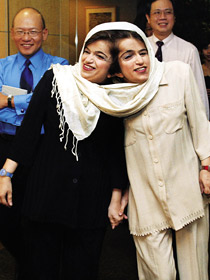Ladan and Laleh Bijani
Ladan and Laleh Bijani were Iranian conjoined twins who gained international attention for their determination to undergo surgical separation. Born on January 17, 1974, in Shiraz, Iran, the Bijani sisters were joined at the head, a condition known as craniopagus conjoining, which is among the rarest forms of conjoined twinning. Despite the risks involved, Ladan and Laleh sought to live independently of each other, a decision that led to a highly publicized and complex surgical procedure in July 2003.
Early Life[edit | edit source]
Ladan and Laleh Bijani were raised in a small village near Shiraz. They were adopted by a doctor and his wife, who provided for their education and upbringing. The sisters were bright and ambitious, each with her own distinct personality and interests. Ladan aspired to be a lawyer, while Laleh aimed to pursue a career in journalism. Their condition did not hinder their academic achievements; they both graduated from the University of Tehran, demonstrating remarkable determination and resilience.
Decision for Separation[edit | edit source]
From an early age, Ladan and Laleh expressed a desire to be separated, despite the risks involved. Their case was brought to the attention of medical professionals around the world. In 2003, after years of consultations, they were accepted for surgery at the Raffles Hospital in Singapore. The decision was controversial, with many medical experts warning of the high risks, including the possibility of death or severe brain damage for one or both sisters. However, Ladan and Laleh were determined to proceed, stating their desire to lead individual lives as their primary motivation.
Surgical Procedure[edit | edit source]
The surgery took place in July 2003 and was led by a team of over 28 surgeons and specialists from various countries. The operation was expected to last up to 48 hours and involved separating the shared blood vessels and brain tissues. The complexity of the surgery was unprecedented, given the extensive sharing of critical anatomical structures.
Outcome and Legacy[edit | edit source]
Tragically, both Ladan and Laleh Bijani died from severe blood loss during the operation on July 8, 2003. Their deaths prompted a global outpouring of sympathy and raised ethical questions about the limits of medical intervention. The Bijani sisters' courage and determination to pursue a chance at individual lives left a lasting impact on the world, sparking discussions on medical ethics, the rights of conjoined twins, and the human spirit's resilience.
The story of Ladan and Laleh Bijani highlights the challenges faced by conjoined twins and the complex ethical considerations involved in separation surgeries. Their legacy continues to inspire and influence debates in the fields of medical ethics, surgery, and patient rights.
Search WikiMD
Ad.Tired of being Overweight? Try W8MD's physician weight loss program.
Semaglutide (Ozempic / Wegovy and Tirzepatide (Mounjaro / Zepbound) available.
Advertise on WikiMD
|
WikiMD's Wellness Encyclopedia |
| Let Food Be Thy Medicine Medicine Thy Food - Hippocrates |
Translate this page: - East Asian
中文,
日本,
한국어,
South Asian
हिन्दी,
தமிழ்,
తెలుగు,
Urdu,
ಕನ್ನಡ,
Southeast Asian
Indonesian,
Vietnamese,
Thai,
မြန်မာဘာသာ,
বাংলা
European
español,
Deutsch,
français,
Greek,
português do Brasil,
polski,
română,
русский,
Nederlands,
norsk,
svenska,
suomi,
Italian
Middle Eastern & African
عربى,
Turkish,
Persian,
Hebrew,
Afrikaans,
isiZulu,
Kiswahili,
Other
Bulgarian,
Hungarian,
Czech,
Swedish,
മലയാളം,
मराठी,
ਪੰਜਾਬੀ,
ગુજરાતી,
Portuguese,
Ukrainian
Medical Disclaimer: WikiMD is not a substitute for professional medical advice. The information on WikiMD is provided as an information resource only, may be incorrect, outdated or misleading, and is not to be used or relied on for any diagnostic or treatment purposes. Please consult your health care provider before making any healthcare decisions or for guidance about a specific medical condition. WikiMD expressly disclaims responsibility, and shall have no liability, for any damages, loss, injury, or liability whatsoever suffered as a result of your reliance on the information contained in this site. By visiting this site you agree to the foregoing terms and conditions, which may from time to time be changed or supplemented by WikiMD. If you do not agree to the foregoing terms and conditions, you should not enter or use this site. See full disclaimer.
Credits:Most images are courtesy of Wikimedia commons, and templates Wikipedia, licensed under CC BY SA or similar.
Contributors: Prab R. Tumpati, MD

